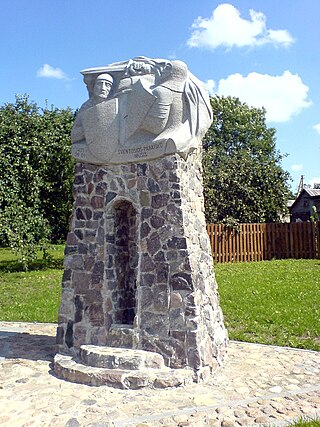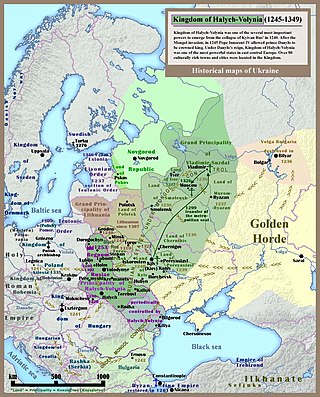
Švitrigaila was the Grand Duke of Lithuania from 1430 to 1432. He spent most of his life in largely unsuccessful dynastic struggles against his cousins Vytautas and Sigismund Kęstutaitis.

Jaunutis was Grand Duke of Lithuania after his father Gediminas died in 1341 until he was deposed by his elder brothers Algirdas and Kęstutis in 1345.

The Union of Horodło or Pact of Horodło was a set of three acts signed in the town of Horodło on 2 October 1413. The first act was signed by Władysław II Jagiełło, King of Poland, and Vytautas, Grand Duke of Lithuania. The second and third acts were composed by the Polish nobility (szlachta) and Lithuanian boyars, respectively. The union amended the earlier Polish–Lithuanian unions of Krewo and Vilnius–Radom. Politically, Lithuania received more autonomy as, after the death of Vytautas, the Lithuanian nobles could choose another Grand Duke instead of passing the title to Władysław II Jagiełło or his heir. However, culturally, Lithuania and Poland grew closer. Lithuania adopted Polish institutions of castellans and voivodes. Catholic Lithuanian nobles and church officials were granted equal rights with the Polish nobles and clergy. Forty-seven selected Lithuanian nobles were adopted by Polish families and granted Polish coats of arms. Thus the union signified the beginnings of the Polonization of Lithuanian culture and the rise of the Lithuanian nobility. It was one of the major steps towards the modernization and Europeanization of Lithuania.
Karijotas or Koriat was the Duke of Navahrudak and Vaŭkavysk, one of the sons of Gediminas, Grand Duke of Lithuania.

Liubartas or Demetrius of Liubar was Prince of Lutsk and Liubar (Volhynia) (1323–1383), Prince of Zhytomyr (1363–1374), Grand Prince of Volhynia (1340–1383), Grand Prince of Halych–Volhynia (1340–1349).

Vaidotas was a son of Kęstutis, Grand Duke of Lithuania. In reliable historical sources he is mentioned only twice: as defender of Kaunas Castle in 1362 and as ruler of Navahrudak. Due to very limited information, his life is subject to wide-ranging theories by historians.

The Battle of Wiłkomierz took place on September 1, 1435, near Ukmergė in the Grand Duchy of Lithuania. With the help of military units from the Kingdom of Poland, the forces of Grand Duke Sigismund Kęstutaitis soundly defeated Švitrigaila and his Livonian allies. The battle was a decisive engagement of the Lithuanian Civil War (1432–1438). Švitrigaila lost most of his supporters and withdrew to southern Grand Duchy; he was slowly pushed out and eventually made peace. The damage inflicted upon the Livonian Order has been compared to the damage of Battle of Grunwald upon the Teutonic Order. It was fundamentally weakened and ceased to play a major role in Lithuanian affairs. The battle can be seen as the final engagement of the Lithuanian Crusade.

The Treaty of Dovydiškės, Daudiske, or Daudisken was a secret treaty signed on 31 May 1380 between Jogaila, the Grand Duke of Lithuania, and Winrich von Kniprode, the Grand Master of the Teutonic Knights. The treaty was directed against Jogaila's uncle Kęstutis and its effect was to precipitate the Lithuanian Civil War (1381–1384).
The Treaty of Königsberg was signed in Königsberg (Królewiec) on May 26, 1390 during the Lithuanian Civil War (1389–1392) between Samogitian nobles and representatives of the Teutonic Knights. The 31-member or 30-member delegation from seven Samogitian regions arrived to Königsberg around the pentecost. They promised their loyalty to "their king" Vytautas and guaranteed trade freedom for the Knights in Samogitia. The Knights gifted the nobles with food and clothes.

The family of Gediminas is a group of family members of Gediminas, Grand Duke of Lithuania, who interacted in the 14th century. The family included the siblings, children, and grandchildren of the Grand Duke and played the pivotal role in the history of Lithuania for the period as the Lithuanian nobility had not yet acquired its influence. Gediminas was also the forefather of the Gediminid dynasty, which ruled the Grand Duchy of Lithuania from 1310s or 1280s to 1572.

The Lithuanian Civil War of 1432–1438 was a war of succession to the throne of the Grand Duchy of Lithuania, after Vytautas the Great died in 1430 without leaving an heir. The war was fought on the one side by Švitrigaila, allied with the Teutonic Knights, and on the other by Sigismund Kęstutaitis, backed by the Kingdom of Poland. The war threatened to sever the Union of Krewo, the personal union between Poland and Lithuania. Švitrigaila's alliance with the Grand Master of the Teutonic Order, Paul von Rusdorf, launched the Polish–Teutonic War (1431–1435) but failed to secure victory for Švitrigaila.

The signatories of the Act of Independence of Lithuania were the twenty Lithuanian men who signed the Act of Independence of Lithuania on February 16, 1918. The signatories were elected to the Council of Lithuania by the Vilnius Conference in September 1917 and entrusted with the mission of establishing an independent Lithuanian state. The proclaimed independence was established only in late 1918, after Germany lost World War I and its troops retreated from Lithuanian territory. What followed was a long process of building the state, determining its borders, and gaining international diplomatic recognition. The signatories succeeded in their mission and independent Lithuania survived until the Soviet Union occupied the state on June 15, 1940.
Fiodor was the prince of Kiev until 1362. Most likely he was the son of Butvydas, and a younger brother of Gediminas, the grand duke of Lithuania, his pagan name is unknown and he was baptized as Orthodox Fiodor. Only a couple of short notes survive regarding Fiodor's life.

De moribus tartarorum, lituanorum et moscorum is a 16th-century Latin treatise by Michalo Lituanus. The work, which was originally dedicated to King of Poland and Grand Duke of Lithuania Sigismund II Augustus, survived only in ten fragments that were first published in 1615 by Johann Jacob Grasser in Basel, Switzerland.

The Galicia–Volhynia Wars were several wars fought in the years 1340–1392 over the succession in the Kingdom of Galicia–Volhynia, also known as Ruthenia. After Yuri II Boleslav was poisoned by local Ruthenian nobles in 1340, both the Grand Duchy of Lithuania and the Kingdom of Poland advanced claims over the kingdom. After a prolonged conflict, Galicia–Volhynia was partitioned between Poland (Galicia) and Lithuania (Volhynia) and Ruthenia ceased to exist as an independent state. Poland acquired a territory of approximately 52,000 square kilometres (20,000 sq mi) with 200,000 inhabitants.
Ritterswerder was a short-lived wooden castle built by the Teutonic Order in fall 1391. It was located on an island in the Neman River near Lampėdžiai, now part of the city of Kaunas.

The Lithuanian Civil War of 1381–1384 was the first struggle for power between the cousins Jogaila, Grand Duke of Lithuania and later King of Poland, and Vytautas the Great. It began after Jogaila signed the Treaty of Dovydiškės with the Teutonic Knights which was aimed against his uncle Kęstutis, father of Vytautas. Kęstutis briefly seized power in the Grand Duchy, but was betrayed by adherents of Jogaila primarily from Vilnius. During negotiations for a truce Kęstutis and Vytautas were arrested and transported to the Kreva Castle. Kęstutis died there a week later but Vytautas managed to escape and then sought an alliance with the Teutonic Knights. Subsequently their joint forces raided Lithuanian lands. Eventually the cousins were reconciled as Jogaila needed internal stability in anticipation of negotiations with the Grand Duchy of Moscow and the Kingdom of Poland regarding the possible Christianization of Lithuania. The war did not settle the power struggle; it continued during the next Lithuanian Civil War (1389–1392) which was resolved by the signing of the Ostrów Agreement. After more than ten years of struggle, Vytautas finally became the Grand Duke of Lithuania and ruled the country for thirty-eight years.
The Battle of Rudau was a medieval pitched battle fought between the Teutonic Knights and the Grand Duchy of Lithuania on 17 or 18 February 1370 near Rudau village, north of Königsberg. According to the Teutonic chronicler Wigand of Marburg and the Livonian chronicle of Hermann de Wartberge, the Lithuanians suffered a great defeat.
Tėvynės sargas was a Lithuanian-language periodical first established in 1896 in Tilsit, East Prussia during the Lithuanian press ban and the Lithuanian National Revival. It was published by the clergy and later by the Christian Democrats, thus it reflected and advocated for Roman Catholic ideals and values. Its motto was "All for Lithuania, Lithuania for Christ". With interruptions, it was published until 2000.
Jonas Vaidutis was a Lithuanian duke and priest from the Lithuanian Gediminid dynasty. Vaidutis was a son of Lithuanian duke Butautas and a grandson of the former Lithuanian monarch Kęstutis. He titled himself as the Duke of Drohiczyn.











